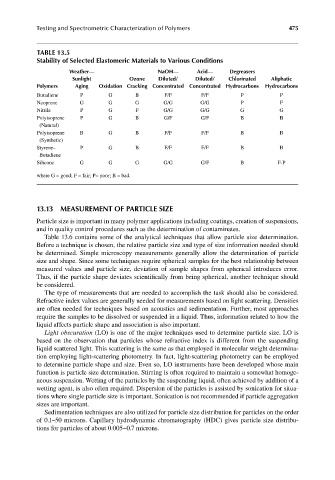Page 512 - Carrahers_Polymer_Chemistry,_Eighth_Edition
P. 512
Testing and Spectrometric Characterization of Polymers 475
TABLE 13.5
Stability of Selected Elastomeric Materials to Various Conditions
Weather— NaOH— Acid— Degreasers
Sunlight Ozone Diluted/ Diluted/ Chlorinated Aliphatic
Polymers Aging Oxidation Cracking Concentrated Concentrated Hydrocarbons Hydrocarbons
Butadiene P G B F/F F/F P P
Neoprene G G G G/G G/G P F
Nitrile P G F G/G G/G G G
Polyisoprene P G B G/F G/F B B
(Natural)
Polyisoprene B G B F/F F/F B B
(Synthetic)
Styrene– P G B F/F F/F B B
Butadiene
Silicone G G G G/G G/F B F-P
where G = good; F = fair; P= poor; B = bad.
13.13 MEASUREMENT OF PARTICLE SIZE
Particle size is important in many polymer applications including coatings, creation of suspensions,
and in quality control procedures such as the determination of contaminates.
Table 13.6 contains some of the analytical techniques that allow particle size determination.
Before a technique is chosen, the relative particle size and type of size information needed should
be determined. Simple microscopy measurements generally allow the determination of particle
size and shape. Since some techniques require spherical samples for the best relationship between
measured values and particle size, deviation of sample shapes from spherical introduces error.
Thus, if the particle shape deviates scientifically from being spherical, another technique should
be considered.
The type of measurements that are needed to accomplish the task should also be considered.
Refractive index values are generally needed for measurements based on light scattering. Densities
are often needed for techniques based on acoustics and sedimentation. Further, most approaches
require the samples to be dissolved or suspended in a liquid. Thus, information related to how the
liquid affects particle shape and association is also important.
Light obscuration (LO) is one of the major techniques used to determine particle size. LO is
based on the observation that particles whose refractive index is different from the suspending
liquid scattered light. This scattering is the same as that employed in molecular weight determina-
tion employing light-scattering photometry. In fact, light-scattering photometry can be employed
to determine particle shape and size. Even so, LO instruments have been developed whose main
function is particle size determination. Stirring is often required to maintain a somewhat homoge-
neous suspension. Wetting of the particles by the suspending liquid, often achieved by addition of a
wetting agent, is also often required. Dispersion of the particles is assisted by sonication for situa-
tions where single particle size is important. Sonication is not recommended if particle aggregation
sizes are important.
Sedimentation techniques are also utilized for particle size distribution for particles on the order
of 0.1–50 microns. Capillary hydrodynamic chromatography (HDC) gives particle size distribu-
tions for particles of about 0.005–0.7 microns.
9/14/2010 3:42:19 PM
K10478.indb 475 9/14/2010 3:42:19 PM
K10478.indb 475

